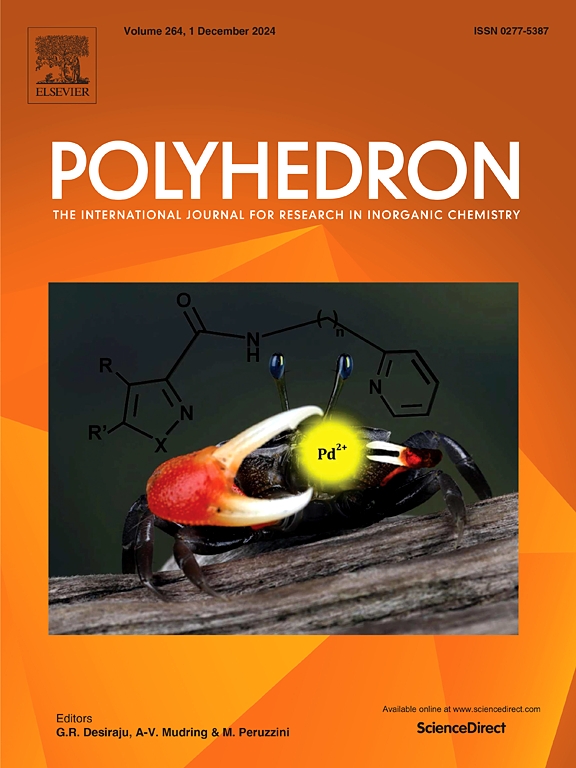利用单晶x射线衍射、红外光谱、热分析和赫希菲尔德表面分析对草酸氢铯的合成、晶体结构和化学式进行重新研究
IF 2.4
3区 化学
Q2 CHEMISTRY, INORGANIC & NUCLEAR
引用次数: 0
摘要
在制备含有Cr和Cs原子的双金属聚合物草酸盐的过程中,从x射线粉末衍射中分离出无色单晶,并鉴定为CsHC2O4,表明该化合物与Kholodkovskaya (Space Group P21/c)先前报道的化合物具有同型。由于缺乏一些结构数据,利用新的和更多的晶体学数据对其结构进行了重新研究。在不对称单元中存在两个独立的C原子和只有一个H原子,其中有一个Cs原子,并且对称中心位于两种CC键的中心,因此可以提出化学式Cs2(C2O4)(H2C2O4) (I)。结构由CsO11多面体通过C2O42−离子共享相反面的锯齿形文件组成,并沿[0 0 1]方向形成由H2C2O4配体层分隔的双层结构。通过与同源化合物的比较,红外光谱研究与XRD数据一致。不同大气条件下的热分析ATG和DTA显示了该二维化合物的不同热分解过程。Hirshfeld表面分析及其相应的二维指纹图谱显示,晶体堆积的主要贡献者是Cs⋯O接触,其次是O⋯C、O⋯O和O⋯H接触。本文章由计算机程序翻译,如有差异,请以英文原文为准。

Synthesis, crystal structure reinvestigation and chemical formula redefinition of cesium hydrogen oxalate by single crystal X-ray diffraction, IR spectroscopy, thermal and Hirshfeld surface analysis
In attempt to prepare a bimetallic polymer oxalate with Cr and Cs atoms, colorless single crystals have been isolated and identified as CsHC2O4, from X-ray powder diffraction which shown the compound to be isotypic with that reported previously by Kholodkovskaya (Space Group P21/c). On the lack of some structural data, its structure has been reinvestigated using new and more crystallographic data. Two independent C atoms and only one H atom are present in the asymmetric unit, with one Cs atom and moreover, the symmetry center is located on the center of the two kinds of C![]() C bonds, allowing to propose the chemical formula Cs2(C2O4)(H2C2O4) (I).The structure consists of zigzag files of CsO11 polyhedra sharing opposite faces via the C2O42− ions and form double layers separated by H2C2O4 ligand layers, along [0 0 1] direction. The IR spectroscopy study, carried out by comparison with homologous compounds, is in agreement with XRD data. The thermal analysis ATG and DTA performed under different atmospheric conditions, showed different thermal decomposition process for this bidimensional (2D) compound. The Hirshfeld surface analysis and its corresponding 2D fingerprint plots revealed that the major contributors to the crystal packing are Cs⋯O contacts followed by O⋯C, O⋯O, and O⋯H contacts.
C bonds, allowing to propose the chemical formula Cs2(C2O4)(H2C2O4) (I).The structure consists of zigzag files of CsO11 polyhedra sharing opposite faces via the C2O42− ions and form double layers separated by H2C2O4 ligand layers, along [0 0 1] direction. The IR spectroscopy study, carried out by comparison with homologous compounds, is in agreement with XRD data. The thermal analysis ATG and DTA performed under different atmospheric conditions, showed different thermal decomposition process for this bidimensional (2D) compound. The Hirshfeld surface analysis and its corresponding 2D fingerprint plots revealed that the major contributors to the crystal packing are Cs⋯O contacts followed by O⋯C, O⋯O, and O⋯H contacts.
求助全文
通过发布文献求助,成功后即可免费获取论文全文。
去求助
来源期刊

Polyhedron
化学-晶体学
CiteScore
4.90
自引率
7.70%
发文量
515
审稿时长
2 months
期刊介绍:
Polyhedron publishes original, fundamental, experimental and theoretical work of the highest quality in all the major areas of inorganic chemistry. This includes synthetic chemistry, coordination chemistry, organometallic chemistry, bioinorganic chemistry, and solid-state and materials chemistry.
Papers should be significant pieces of work, and all new compounds must be appropriately characterized. The inclusion of single-crystal X-ray structural data is strongly encouraged, but papers reporting only the X-ray structure determination of a single compound will usually not be considered. Papers on solid-state or materials chemistry will be expected to have a significant molecular chemistry component (such as the synthesis and characterization of the molecular precursors and/or a systematic study of the use of different precursors or reaction conditions) or demonstrate a cutting-edge application (for example inorganic materials for energy applications). Papers dealing only with stability constants are not considered.
 求助内容:
求助内容: 应助结果提醒方式:
应助结果提醒方式:


